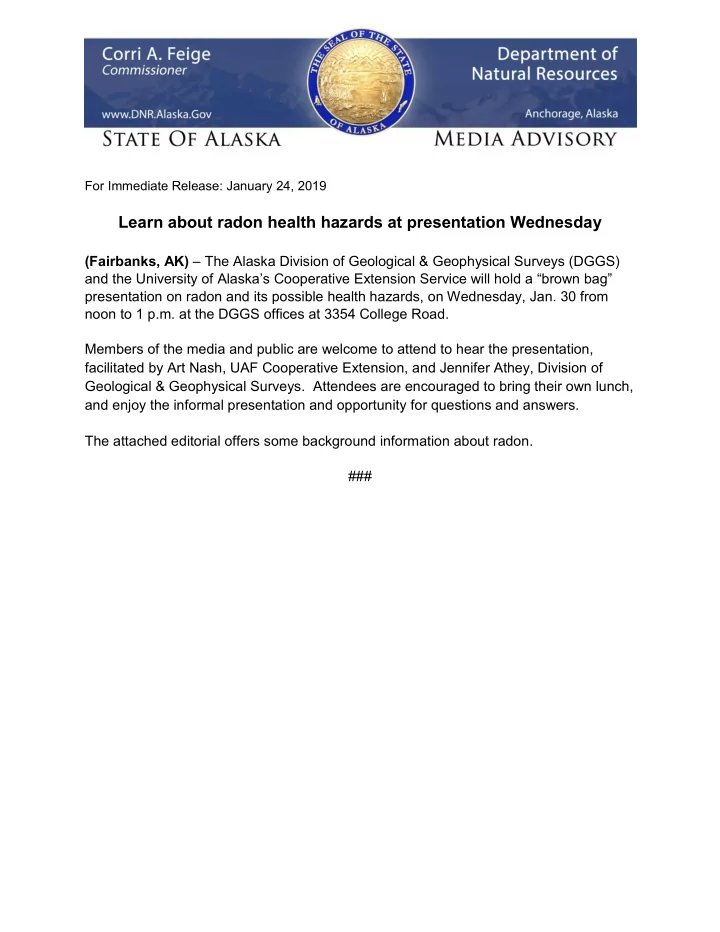

For Immediate Release: January 24, 2019 Learn about radon health hazards at presentation Wednesday (Fairbanks, AK) – The Alaska Division of Geological & Geophysical Surveys (DGGS) and the University of Alaska’s Cooperative Extension Service will hold a “brown bag” presentation on radon and its possible health hazards, on Wednesday, Jan. 30 from noon to 1 p.m. at the DGGS offices at 3354 College Road. Members of the media and public are welcome to attend to hear the presentation, facilitated by Art Nash, UAF Cooperative Extension, and Jennifer Athey, Division of Geological & Geophysical Surveys. Attendees are encouraged to bring their own lunch, and enjoy the informal presentation and opportunity for questions and answers. The attached editorial offers some background information about radon. ###
For Immediate Release: January 24, 2019 Editorial: Big or small, radiation can affect your health By Art Nash and Jennifer Athey (Fairbanks, AK) – Certain words can create anxiety depending on your life experiences. One of those words is radiation. This is especially true for those of us who grew up during the Cold War and had under-the-desk drills, saw yellow rectangle “Fallout Shelter” signs at school and came to know geography framed by Hiroshima, Nagasaki, Three-Mile Island and Chernobyl. It’s important to talk about the intensity and duration of radiation exposure and physiological effects that occur with different radiation sources when gauging and discussing the risk of radiation to human health. The sun gives off radiation, which can cause skin cancer after prolonged periods of solar exposure. Radioactive radon gas in homes originates from naturally occurring uranium in rocks and soils. Similar to the effects of solar radiation, exposure to radon gas can cause lung cancer after you breathe it in. In both cases, your likelihood of getting cancer is highly influenced by length of exposure time to these very low-dose radiation sources. Many of Alaska’s rocks and soils contain enough uranium to produce dangerous levels of radon when concentrated in a home’s air. Where it can migrate up to the surface, radon gas may enter buildings through even tiny holes in the interface between your home and the ground. Homes constructed in seismically active areas are especially susceptible to radon intrusion. For example, the 7.0 earthquake that rattled Anchorage on Nov. 30 created breaches and fissures in foundations, potentially allowing radon gas traveling through newly formed cracks in soil and rock to seep inside. Environmental Protection Agency-endorsed testing protocol from the American Association of Radon Scientists and Technicians recommends that homeowners test for radon every five years, after significant seismic events like Anchorage’s recent
earthquake and after other events and activities that may change the air flow or structure of your home, such as home remodels. Yet, let’s be clear, radon’s low-level radiation starts with a small “r.” Alternatively, the nuclear power plant core meltdowns at Fukushima eight years ago involved larger amounts of radiation, the big “R.” The first fatality associated with cleanup of Fukushima’s contaminated materials occurred only several years after the disaster. Daily exposure to radon over the life of a typical home mortgage may also cause cancer — in fact, about 20,000 people in the U.S. die from breathing radon every year. It is the second leading cause of lung cancer. The long exposure time also provides ample opportunity to make sure your home’s level of radon stays below the EPA’s action level of 4 picocuries per liter. In one sense, radon may be more of a health risk than processed uranium. Changes to the body’s tissues from radon are not symptomatic until significant lung damage has occurred, unlike the nausea, skin lesions and burns that we associate with very high doses of radiation. In fact, you can’t smell, taste or see radon gas. The only way you’ll know if you have a high radon concentration is to test your home’s air, and that measurement can fluctuate according to how you run your HRV, bathroom fan and hood range in normal daily operations and with other factors over time. Short-term tests (up to 96 hours) and long-term tests (up to a year) are both good options, depending on whether you want a quick snapshot or yearly average of the radon concentration in your home. In short, radiation from natural exposure to the sun or escaping radon gas is important to be aware of and to mitigate. January is National Radon Action Month, and we encourage you to test if you haven’t in the last five years, or if your home’s structure or airflow has been altered. If you have questions about testing methods, device placement or how to fix your home, call the Alaska Radon Hotline at 1-800-478-8324. If you’re interested in learning more, Art Nash will lead a radon workshop at 5 p.m. Jan. 29 at the Nenana Student Living Center and will schedule other workshops as requested. ### Art Nash is the extension energy and radon specialist for the University of Alaska Fairbanks Cooperative Extension Service. Contact him at (907) 474-6366 or by email at alnashjr@alaska.edu.
Jennifer Athey is a geologist with the Alaska Division of Geological & Geophysical Surveys. Contact her at (907) 451-5028, or by email at jennifer.athey@alaska.gov
Recommend
More recommend